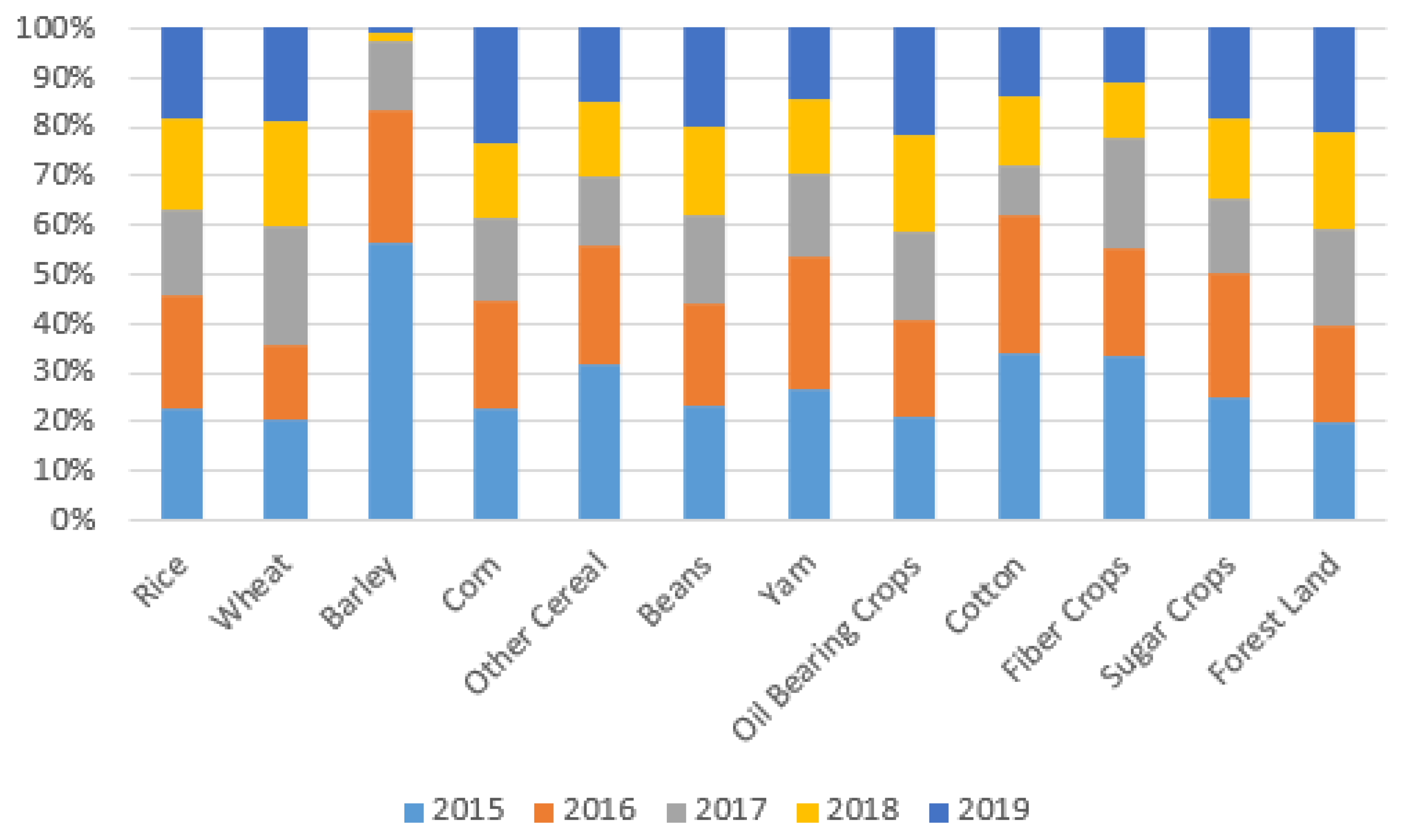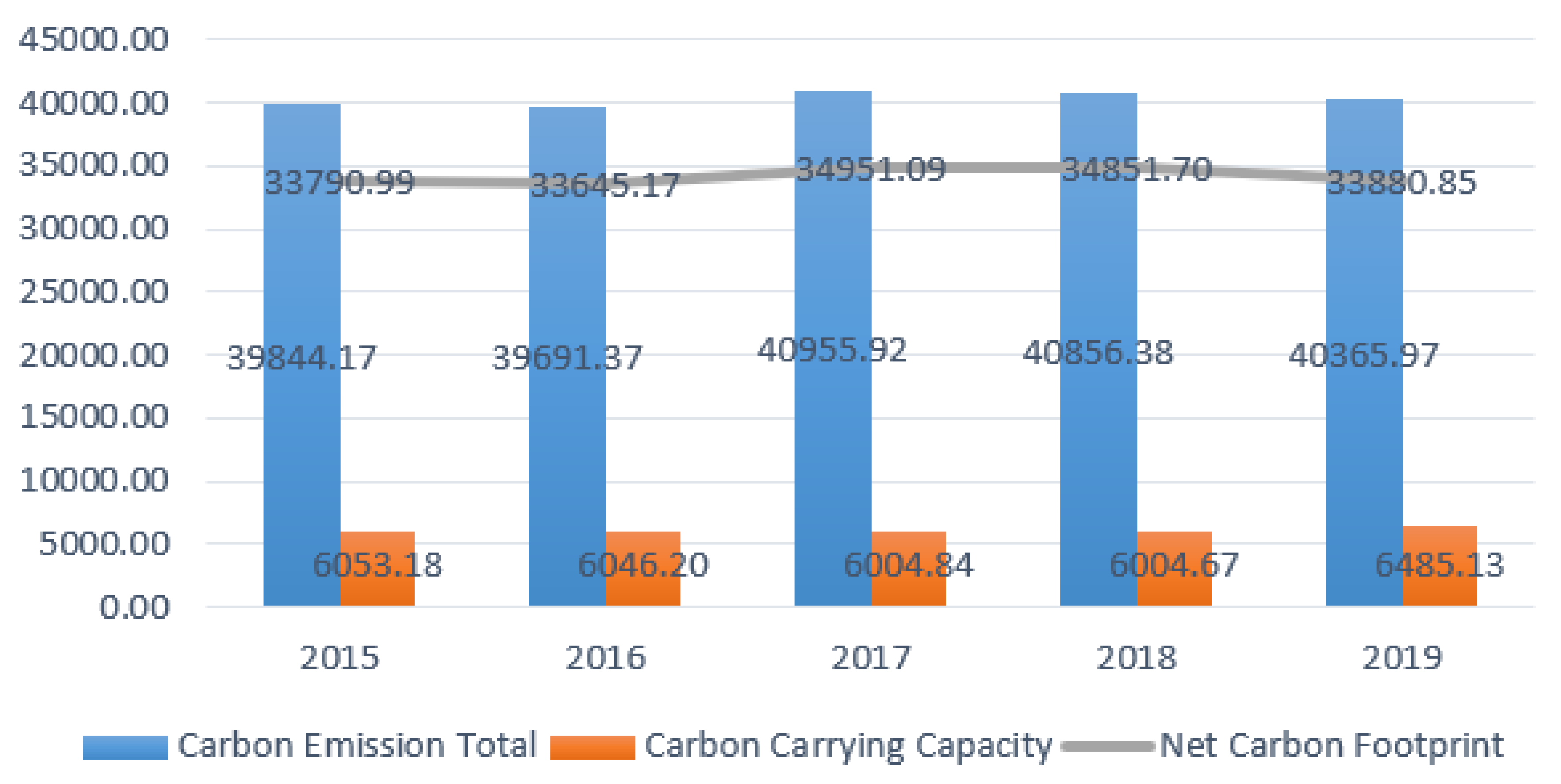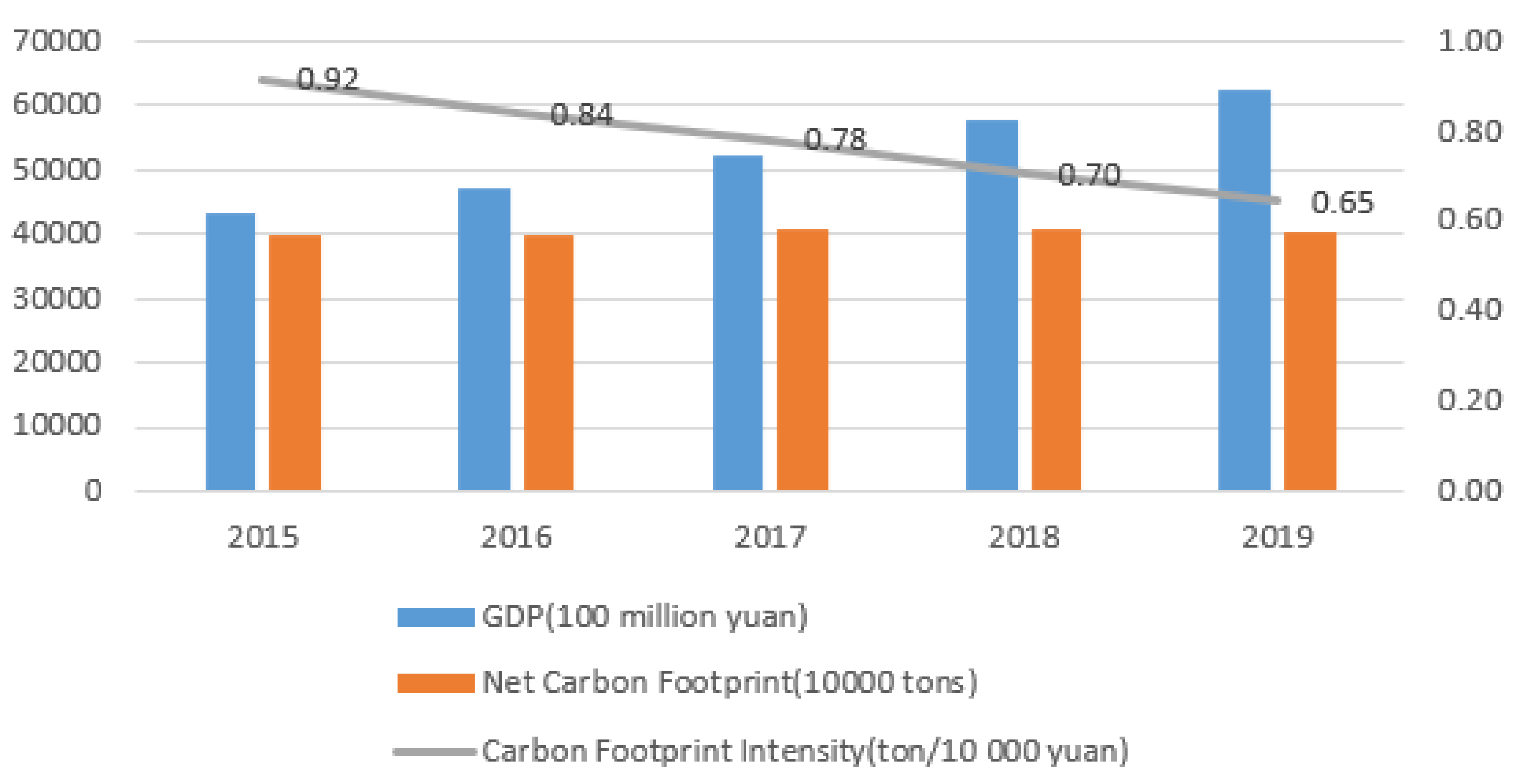5.1. Result Analysis
- (1)
Net Carbon Footprint Showing a Downward Trend
According to the above analysis, the net carbon footprint of Zhejiang Province shows a downward trend, but all factors are in a state of carbon deficit. The main reason is that the total carbon emission is high and the carbon-carrying capacity is low. The energy consumption and industrial production of Zhejiang Province have produced a large carbon footprint. Although the total energy consumption in Zhejiang Province decreased from 350.2483 million tons in 2015 to 346.442 million tons in 2019, there is still much room for reduction. For example, we should vigorously develop new energy technologies, strengthen the development and utilization of wind, light, tidal, and other new energies, to save the use of coal, oil, natural gas, and other traditional energies.
As one of the three major building materials, the cement output in Zhejiang Province increased from 48.1934 million tons in 2015 to 57.2177 million tons in 2019, which is closely related to the development of the construction industry and economic development in Zhejiang Province. As a substitute for cement, “coagulate” (invented by Henghu Sun, professor at Tsinghua University) provides a new idea for reducing cement production. As shown in
Table 4, the area of forest land in Zhejiang Province was relatively stable from 2015 to 2018 and increased significantly in 2019. This is because the State Council’s third national land survey in 2019 used satellite remote sensing, the Internet, cloud computing, and other technologies to make the collected land data more accurate based on the latest orthophoto map. According to statistics, the forest coverage rate of Zhejiang Province in 2020 was 59.43%, ranked fifth in China. Compared with Fujian Province, which ranked first (with a forest coverage rate of 66.80%), there is still much room for improvement.
As shown in
Table 4, the carbon-carrying capacity of crops in Zhejiang Province has declined year by year, which is closely related to the annual reduction in total crop output. Zhejiang Province is located in the economically developed area in the east of China, and the urbanization process is speeding up, and it thus provides a large amount of cultivated land. Due to the increasing demand for vegetables and flowers, the agricultural structure of Zhejiang Province has changed, and some cultivated land has changed to growing vegetables and flowers. That is the main reason for the decrease in crop output in Zhejiang Province year by year.
- (2)
Carbon Footprint Intensity of GDP Showing a Downward Trend
As shown in
Figure 3, the carbon dioxide emission per CNY 10,000 of GDP in Zhejiang Province shows a downward trend, indicating that the effect of emission reduction and energy efficiency improved in Zhejiang Province. In general, the intensity of the carbon footprint with respect GDP in Zhejiang Province is lower than the national average. However, there is still a certain gap compared with the world average. This also presents higher requirements for Zhejiang Province’s technological progress, economic growth, changes in industrial structure, agricultural industrialization, and urbanization. The intensity of the carbon footprint with respect to GDP is a relative indicator, and its downward trend is the result of the joint action of the higher GDP growth rate and the annual reduction in total carbon emissions in Zhejiang Province.
Digital economy and industrial production have made important contributions to the economic growth of Zhejiang Province, which is an important factor in the decline of the intensity of the carbon footprint with respect to GDP in Zhejiang Province. Zhejiang Province has always attached great importance to energy conservation and emission reduction and advocated green and low-carbon development. These have enabled Zhejiang Province to maintain high economic growth while reducing its total carbon emission each year.
- (3)
Carbon Footprint Per Capita Showing a Downward Trend
As shown in
Figure 4, the carbon footprint per capita of Zhejiang Province shows a downward trend, decreasing to 6.33 tons/person in 2019. The global level is 4.48 t/person [
42], and the per capita carbon footprint of Zhejiang Province is 1.41 times the global level. Nearly half (47%) of the carbon footprint is generated by the consumption of raw coal energy in Zhejiang Province. At the same time, the proportion of urban areas in carbon footprint analysis is relatively high [
42]. The carbon emissions are related to the production of goods and services consumed by them. Its urban areas, accounting for only 2% of the world, account for about 80% of global greenhouse gas emissions [
43,
44]. BP world energy data show that China’s carbon dioxide emissions in 2020 will be 9.894 billion tons, and the national per capita carbon emissions will be 7 tons/person. The per capita carbon footprint of Zhejiang Province is lower than the overall national level, which is only 0.67 t/person less. The situation is not optimistic, and efforts should be made to save energy and reduce carbon. According to the map of global per capita carbon emission information produced on the Virtual Capitalist website, the per capita carbon footprints of Canada and the United States are 15.2 tons and 14.4 tons per year, respectively, more than three times higher than the global average, while the per capita carbon footprints of Zhejiang Province are lower than those of Canada and the United States but still higher than the global level. The permanent population of Zhejiang Province is still growing. If the carbon footprint per capita is reduced to the world average, we must increase efforts to control the total carbon emissions.
Zhejiang Province has not yet established a green low-carbon circular economy system; a clean low-carbon, safe, and efficient energy system; or a long-term carbon neutral mechanism. Further exploration and extensive application of low-carbon, zero-carbon and negative-carbon technologies need to be strengthened. The proportion of non-fossil energy consumption still has a large downward space. Clean production and low-carbon transformation of the high-carbon industry need to be improved. Therefore, Zhejiang Province strictly controls energy consumption intensity, carbon dioxide emission intensity, and total energy consumption and strengthens the development and utilization of new energy and green energy.
5.2. Countermeasures and Suggestions
- (1)
Improve Energy Efficiency and Promote the Green Energy Revolution
In order to reduce the proportion of coal energy consumption in the industrial energy consumption structure, Zhejiang Province has concentrated on the development and utilization of renewable energy. Energy efficiency and the green energy revolution depend on technological improvement and innovation. There are energy-saving technologies to be improved in traditional industries and high-carbon industries in Zhejiang Province, because these industries result in low energy efficiency and high carbon emissions.
Zhejiang Province can vigorously support and promote energy-saving technology research and development projects and improve the traditional process to achieve energy conservation and emission reduction. In order to promote the realization of the national “double carbon” goal, the energy industry of Zhejiang Province has new opportunities for accurate green and low-carbon transformation. These include improving the efficiency and effect of new energy, advanced nuclear energy, new energy storage, hydrogen energy, and other emerging energy types; accelerating the iterative pace of emerging energy; targeting industries using to emerging energy. In doing so, Zhejiang Province will make precise efforts and give certain policy support, guidance, and supervision. Other strategies include integrating big data, cloud computing, blockchain, artificial intelligence, and other technologies into the emerging energy industry and cultivating emerging industries based on emerging energy. For example, emerging industries can be cultivated based on non-fossil energy represented by photovoltaic wind power.
- (2)
Improve Industrial Production Efficiency and Promote Green Industrial Development
As early as 2012, Zhejiang Province took the lead in carrying out “machine replacement” to guide and motivate the usage of machines used in Zhejiang manufacturing plants to replace simple, repetitive, high-intensity, and high-risk posts and to improve product quality and production efficiency. This also involved further integrating industrial production with information technology and expanding the breadth and depth of industrial production based on information technology to improve the efficiency of industrial production.
At the same time, we will formulate laws and regulations for low-carbon economy and technology, refine the standards for industrial production in various industries, and regularly test the comprehensive utilization of industrial solid wastes and the recycling of renewable resources, so as to promote the development of a green low-carbon cycle and green industrial development. The government can increase the proportion of investment into environmental protection, increase the supply of green technology and equipment products, promote the recycling of industrial resources, curb the blind development of high energy consumption and high carbon projects, and curb excessive and repeated construction to protect the ecological environment.
- (3)
Protect and Develop Forest Resources, and Advocate Green Ideas
We firmly believe that green water and green mountains are golden mountains and silver mountains. We will resolutely curb the over-quota logging of forest resources, encourage afforestation and mountain closure, and expand the forest coverage in Zhejiang Province, so as to improve the carbon-carrying capacity of forest land. The government will provide certain economic support or long-term loan policies for afforestation and forest cultivation to stimulate the enthusiasm and initiative of individuals and enterprises in afforestation and forest cultivation. Another strategy is to save the use of wood and encourage research, development, and utilization with respect to wood substitutes. Forest cultivation fees shall be collected and used exclusively for afforestation and forest cultivation. The public should also be encouraged to participate in the supervision of such projects, advocate the concept of green production and green life, and realize the harmonious unity of economic development and ecological protection.
- (4)
Promote the Development of Green Industries and Cultivate Green Innovative Talents
Experience has proved that high-quality green innovative talents can significantly improve carbon emission efficiency. Therefore, green innovative talents should be trained and introduced, and policies for the introduction of green innovative talents should be formulated. Enterprises, universities, scientific research institutions, and service institutions work together to cultivate green innovation talents and form a social atmosphere of respecting talents and advocating green innovation. Enterprises should be encouraged to write green innovation incentives into enterprise rules and regulations and encourage green innovation talents to try and make mistakes. The government should support and encourage enterprises in increasing investment into research and development in green innovation technologies. We will carry out green technology innovation through industry–university research collaboration, strengthen the training of green technology innovation talents and the research and development of key common technologies for green development, build a patent pool for green innovation technologies, and promote the sharing of intellectual property resources for green technology innovation technologies.
- (5)
Comprehensively promote carbon accounts and help enterprises tap carbon-reduction potential
In view of the imbalance between the carbon footprint and the carbon-carrying capacity of Zhejiang Province, building and promoting an enterprise carbon account system has been proposed. On 11 November 2022, at the 27th Conference of the Parties (COP27) to the United Nations Framework Convention on Climate Change, the carbon account finance of Quzhou in Zhejiang Province was presented as a local practice case for climate change policies and actions. It was also recognized by experts. The enterprise carbon account comprehensively records, scientifically calculates, and fairly evaluates the carbon footprint of various enterprises. The enterprise carbon account has become a data governance tool to define the correct boundary for low-carbon contribution, carbon reduction responsibility, and carbon emission among social subjects. The intelligent terminal data-acquisition system of an enterprise carbon account can accurately monitor the carbon emission data of enterprise production, issue timely high-emission warnings, take measures to reduce carbon over time, and continuously reduce the carbon footprint of enterprises. The carbon footprint accounting system for industrial products can be added to the carbon account version 1.0 to establish a carbon footprint tracking path for industrial products. Additionally, it can reduce the carbon footprint of industrial products, apply carbon labels as much as possible, gradually integrate with the world carbon emission standards for industrial products, and lay a foundation for sustainable export of industrial products in Zhejiang Province. Governmental departments can provide necessary financial subsidies for enterprises to build a carbon account system and help enterprises find a balance point for energy conservation and carbon reduction.
- (6)
Fully implement carbon credit reporting and play the role of carbon finance in energy conservation and carbon reduction
Strategies by which the government of Zhejiang Province can achieve intelligent carbon governance, and by which enterprises can achieve intelligent carbon reduction and provide intelligent financial support, include deepening the “5e” closed-loop system of carbon account finance and optimizing the carbon emission e-ledger, carbon credit e-report, carbon policy e-release, carbon finance e-supermarket, and carbon efficiency e-assessment by means of AI, blockchain, online monitoring, and other technologies. Through the “5e” closed-loop system, financial systems can achieve the transformation of the granularity of green finance standards from industry to enterprise, and from qualitative to quantitative, through the quantification of carbon. Through the carbon emission e-account book and carbon credit e-report, we will increase the credit of enterprises in terms of carbon and provide corresponding green financial loans, so as to provide financial support for enterprises to reduce their carbon footprint and achieve the dynamic balance between Zhejiang’s carbon footprint and carbon-carrying capacity as soon as possible.
- (7)
Formulate carbon emission reduction policies to provide support for energy conservation and carbon reduction
Zhejiang’s provincial government and local governments can also formulate relevant policies in terms of increasing financial support for energy conservation and emission reduction. These include strengthening the implementation of governmental green procurement, improving the carbon financial system, speeding up the development of green bonds, promoting enterprises in high-risk areas to obtain environmental pollution liability insurance, and implementing preferential tax policies for environmental protection. At the same time, the mechanism of the carbon market’s operation should be further improved, mainly to carry out trading of energy use rights, trading of emission rights, trading of green power certificate, promoting power demand-side management, promoting energy contract management, opening the market for environmental governance, strengthening energy efficiency labeling management system, implementing a green product certification system, etc.











